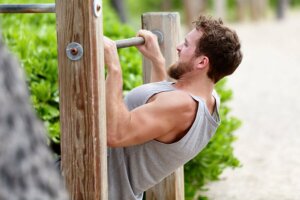Thoracic Hyperkyphosis: Improve Your Posture

In our day-to-day lives, there’s a lot of different ways that we can cause harm to our bodies without even realizing it. One of the most common ways is through poor posture, which can lead to thoracic hyperkyphosis. Let’s take a look at what causes it, how to treat it, and how to improve your posture.
Thoracic (or dorsal) kyphosis is the normal curvature of the anterior concavity of the dorsal spine. Therefore, thoracic hyperkyphosis consists of a pathological increase in this curvature. To put this in a more colloquial way, we’re talking about a “humpback”.
The main cause of this pathological increase is found in our day-to-day posture. The body adapts to your way of life, although this can clearly end up being harmful to your skeleton. In today’s world, with the increase in cellphone and technology use in general, there are endless possibilities to involuntarily develop this disorder.
This topic is extremely important because having hyperkyphosis isn’t solely an aesthetic problem. These “hunchbacks” can lead to problems with balance, weight distribution, and shock absorption, among other things. So how can you improve your posture?
Other causes of thoracic hyperkyphosis
It’s worth noting that people can suffer from hyperkyphosis due to skeletal problems. Pathologies such as malformations and other bone issues can lead to progressively worsening curves in the spine.
The advice that we give in this article isn’t going to cure these pathologies, but it’s still important to slow its advance in order to keep the spine as healthy as possible for as long as possible.
How to improve your posture
The first thing that we have to think about is the sheer amount of time we spend each day seated or lying down. In the car, in the office, the couch, the bus, the movies, eating, sleeping, etc. It’s likely that we spend the majority of each day seated! Therefore, first things first, we have to learn to sit correctly:
- We sit on top of two bones at the end of the buttocks, known as the ischial tuberosity. Therefore, in order to have a correct posture while we’re seated, we need to sit in front of these bones. If you pay attention, it’s more common for people to sit behind them, which is an incorrect posture. By sitting in front of them, you’ll notice how the rest of the spine aligns automatically.

- Rolling your shoulders back. This is a classic mom tip which, as you may guess, is correct. For an ideal posture, lightly raise your shoulders and roll them back. Even if you’re typing on a keyboard, you can make sure your shoulders are well-placed.
- We also need to be mindful of the position of the neck. It’s dangerous to keep the neck in the exact same position for long periods of time. Given this, it’s recommended to frequently rotate and stretch the neck. We often adopt a posture of neck extension. We have to try to remember to bring the neck backward, creating an approximate distance of a fist, between the chin and the chest.
In terms of lying down, it’s preferable to sleep on your side with a pillow between your knees. Also, as a general rule, it’s beneficial to practice “mixed breathing,” combining thoracic breathing with abdominal breathing.
The importance of exercise
Even if your posture is totally correct in your day-to-day life, you also have to work on your musculature. This doesn’t mean you have to spend hours at the gym but simply taking a walk every day will do your body a huge favor.
Also, keep in mind that any act that obliges us to be on our feet will activate the musculature that surrounds the spinal column. This is fundamental because, when all is said and done, the muscles are the part of the body that we can voluntarily control, and it’s the muscles that maintain the rest of the body’s tissues in their position.

On the other hand, if you have time and want to get in a good workout at the gym, there are specific exercises that you can do to strengthen the musculature of the spine. Sports such as swimming and certain weight-lifting machines can help us combat thoracic hyperkyphosis.
As a general rule, the more exercise that you do and the more varied it is, as long as you’re properly warmed up, the better. Health is the result of all the little decisions we make every day!
In our day-to-day lives, there’s a lot of different ways that we can cause harm to our bodies without even realizing it. One of the most common ways is through poor posture, which can lead to thoracic hyperkyphosis. Let’s take a look at what causes it, how to treat it, and how to improve your posture.
Thoracic (or dorsal) kyphosis is the normal curvature of the anterior concavity of the dorsal spine. Therefore, thoracic hyperkyphosis consists of a pathological increase in this curvature. To put this in a more colloquial way, we’re talking about a “humpback”.
The main cause of this pathological increase is found in our day-to-day posture. The body adapts to your way of life, although this can clearly end up being harmful to your skeleton. In today’s world, with the increase in cellphone and technology use in general, there are endless possibilities to involuntarily develop this disorder.
This topic is extremely important because having hyperkyphosis isn’t solely an aesthetic problem. These “hunchbacks” can lead to problems with balance, weight distribution, and shock absorption, among other things. So how can you improve your posture?
Other causes of thoracic hyperkyphosis
It’s worth noting that people can suffer from hyperkyphosis due to skeletal problems. Pathologies such as malformations and other bone issues can lead to progressively worsening curves in the spine.
The advice that we give in this article isn’t going to cure these pathologies, but it’s still important to slow its advance in order to keep the spine as healthy as possible for as long as possible.
How to improve your posture
The first thing that we have to think about is the sheer amount of time we spend each day seated or lying down. In the car, in the office, the couch, the bus, the movies, eating, sleeping, etc. It’s likely that we spend the majority of each day seated! Therefore, first things first, we have to learn to sit correctly:
- We sit on top of two bones at the end of the buttocks, known as the ischial tuberosity. Therefore, in order to have a correct posture while we’re seated, we need to sit in front of these bones. If you pay attention, it’s more common for people to sit behind them, which is an incorrect posture. By sitting in front of them, you’ll notice how the rest of the spine aligns automatically.

- Rolling your shoulders back. This is a classic mom tip which, as you may guess, is correct. For an ideal posture, lightly raise your shoulders and roll them back. Even if you’re typing on a keyboard, you can make sure your shoulders are well-placed.
- We also need to be mindful of the position of the neck. It’s dangerous to keep the neck in the exact same position for long periods of time. Given this, it’s recommended to frequently rotate and stretch the neck. We often adopt a posture of neck extension. We have to try to remember to bring the neck backward, creating an approximate distance of a fist, between the chin and the chest.
In terms of lying down, it’s preferable to sleep on your side with a pillow between your knees. Also, as a general rule, it’s beneficial to practice “mixed breathing,” combining thoracic breathing with abdominal breathing.
The importance of exercise
Even if your posture is totally correct in your day-to-day life, you also have to work on your musculature. This doesn’t mean you have to spend hours at the gym but simply taking a walk every day will do your body a huge favor.
Also, keep in mind that any act that obliges us to be on our feet will activate the musculature that surrounds the spinal column. This is fundamental because, when all is said and done, the muscles are the part of the body that we can voluntarily control, and it’s the muscles that maintain the rest of the body’s tissues in their position.

On the other hand, if you have time and want to get in a good workout at the gym, there are specific exercises that you can do to strengthen the musculature of the spine. Sports such as swimming and certain weight-lifting machines can help us combat thoracic hyperkyphosis.
As a general rule, the more exercise that you do and the more varied it is, as long as you’re properly warmed up, the better. Health is the result of all the little decisions we make every day!
All cited sources were thoroughly reviewed by our team to ensure their quality, reliability, currency, and validity. The bibliography of this article was considered reliable and of academic or scientific accuracy.
- Zurita, F.; Fernández, M.; López C.; Fernández, R. Repercusión de la hipercifosis sobre variables antropométricas y funcionales. Revista Andaluza de Medicina del Deporte, vol. 3, núm. 4, octubre-diciembre, 2010, pp. 138-14
- Brito, L., Espinoza, O., Díaz, Jorge., Lizana, A. Evaluación Postural y Prevalencia de Hipercifosis e Hiperlordosis en Estudiantes de Enseñanza Básica. Int. J. Morphol, 2018, 36( 1 ): 290-296.
- Vaquero, R., Esparza, F., Gómez, R., Martínez, E, et al. Morfología de las curvaturas torácica y lumbar en bipedestación, sedestación y máxima flexión del tronco con rodillas extendidas en bailarinas. Arch Med Deporte 2015;32(2):87-93
This text is provided for informational purposes only and does not replace consultation with a professional. If in doubt, consult your specialist.








